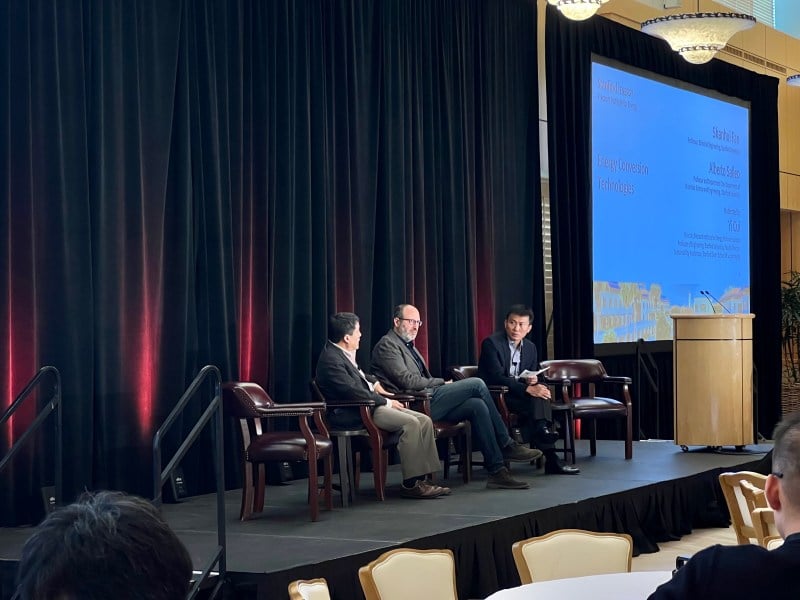On Tuesday, Stanford researchers showcased innovative energy technology developments, from cutting-edge batteries to nature-based carbon capture technologies, as part of Energy Solutions Week.
Stanford Energy Solutions Week was a four-day event held at the Frances C. Arrillaga Alumni Center. Hosted by Precourt Institute for Energy, the invite-only event was the main annual technical symposium to showcase Stanford’s energy-related research this year. Each of the four days focused on a different topic, including energy systems and long duration energy storage.
“The Energy Solutions Week is meant to have our industry partners, university professors and students come together,” said Yi Cui, Director of Precourt Institute for Energy and professor of materials science and engineering in the day’s opening statement.
In a separate interview with The Daily, Cui explained the different purposes of Energy Solutions Week and Global Energy Forum, which was held fall of 2022.
“The GEF was more for policy and leaders coming in,” Cui said. “Now you come back to Energy Solutions Week, and we want to focus on each area of technical solutions and what’s possible.”
During a panel discussion about energy conversion technologies, Shanhui Fan, professor of electrical engineering, described his research on using passive radiation to generate cooling.
Passive radiation cooling is done by using highly-reflective materials to passively reflect light and heat out into space. Using this effect, engineers can essentially cool the material to below ambient temperature, Fan explained.
“With radiative cooling, you’re trying to harvest the coldness of the universe,” Fan said. “The idea was to develop a material that strongly reflects sunlight by radiating. In our experiment on the roof of a Stanford building, you can get a temperature below ambient air passively without electricity.”
Another use of this technology is to generate electricity from temperature differences.
“Almost any material can be made into a radiative cooler, including a solar panel,” Fan said. “Based on this fact, we have recently done an experiment where we put a thermoelectric generator on the back of a solar panel and showed that you could actually get electricity at night.”
While the technology is far from being commercial, research from Fan’s lab shows the potential of combining tried-and-true solar panels with thermoelectric generators.
In another panel, three Stanford professors discussed the future of high energy density lithium metal batteries, which are different from currently used lithium-ion batteries.
“Replacing the graphite anode [in traditional lithium-ion batteries] with lithium metal, we can now have much higher energy density in a small space,” said Wendy Gu, assistant professor of mechanical engineering. “That is possible because now we’re using a solid electrolyte that is much more chemically stable. This lets us package [the battery] into a smaller volume.”
Traditionally, lithium-ion batteries, such as those in electric vehicles, use a liquid electrolyte. The electrolyte is used to conduct electricity within the battery. Solid state batteries using lithium metal improve energy density and get rid of flammable liquids typically used as electrolytes, replacing them with a solid electrolyte, Gu explained.
“There are many types of solid electrolytes with different types of stability,” Gu said. “They’re not without problems, and you’re not getting just a rosy picture.”
Despite its currently many unsolved problems, lithium metal batteries continue to be regarded as “the next generation anode material because of its very high theoretical energy density,” said Renee Zhao, assistant professor of mechanical engineering.
In a separate presentation, Stanford researchers revealed developments in emergent fuels and energy carriers, such as algae-based biofuels and hydrogen.
“Electrification is unavoidable, decarbonization must be real, and hydrogen, hydrogen, hydrogen,” said Matteo Cargnello, associate professor of chemical engineering. “We need carbon-free hydrogen to make other fuels in the future. However, aviation fuel is likely to stick around for a long time.”
A potential solution for aviation is to replace fossil fuels with biofuels. Arthur Grossman, senior staff scientist at the Carnegie Institution for Science, investigated the potential of using algae cells to make biofuels, which are chemically very similar to fossil fuels.
“You could get algae to make a lot of oils that can be drop [sic] in fuels directly used in vehicles,” Grossman said. “Algae can actually make huge amounts of oil. We got them to make up to 85% oil by dry weight.”
The day’s events concluded with a panel presentation about carbon capture and sequestration. During a discussion about the permanence of nature-based solutions, the panelists agreed that the planet needs solutions that are easy to implement as soon as possible.
“Nature-based solutions are available right now,” said Connor Nolan. “It’s a bridge toward permanent technological carbon removal.” Nolan is a postdoctoral fellow at the Woods Institute for the Environment in the Stanford Doerr School of Sustainability.
Despite a broad range of energy technologies discussed at the event, the central purpose of Energy Solutions Week is to solve the energy transition problem with speed and scale by inspiring collaboration and ideas, according Cui.
“If we keep asking questions about scaling, this will activate our faculty and students’ minds very early on,” Cui said. “This I think will have a long term, big impact.”
